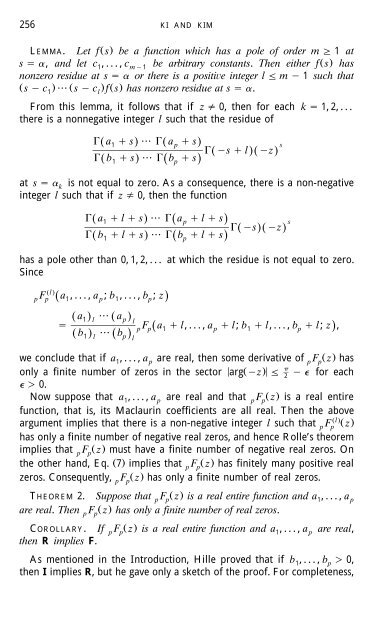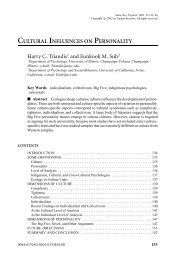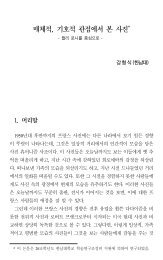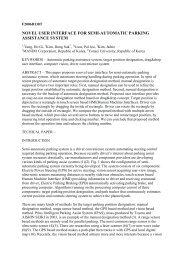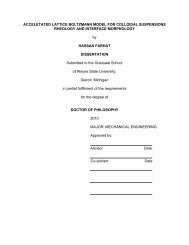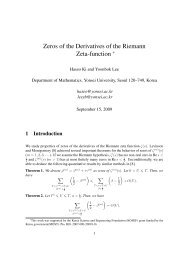On the Zeros of Some Generalized Hypergeometric Functions
On the Zeros of Some Generalized Hypergeometric Functions
On the Zeros of Some Generalized Hypergeometric Functions
You also want an ePaper? Increase the reach of your titles
YUMPU automatically turns print PDFs into web optimized ePapers that Google loves.
256<br />
KI AND KIM<br />
LEMMA. Let fŽ s. be a function which has a pole <strong>of</strong> order m 1 at<br />
s , and let c ,...,c be arbitrary constants. Then ei<strong>the</strong>r fŽ s. 1 m1<br />
has<br />
nonzero residue at s or <strong>the</strong>re is a positie integer l m 1 such that<br />
Ž s c . Ž s c . fŽ s. has nonzero residue at s .<br />
1 l<br />
From this lemma, it follows that if z 0, <strong>the</strong>n for each k 1, 2, . . .<br />
<strong>the</strong>re is a nonnegative integer l such that <strong>the</strong> residue <strong>of</strong><br />
Ž a s. Ž a s.<br />
Ž s l.Ž z.<br />
b s b s<br />
1 p s<br />
Ž . Ž .<br />
1 p<br />
at s is not equal to zero. As a consequence, <strong>the</strong>re is a non-negative<br />
k<br />
integer l such that if z 0, <strong>the</strong>n <strong>the</strong> function<br />
Ž . Ž .<br />
Ž . Ž .<br />
a l s a l s<br />
1 p s<br />
b l s b l s<br />
1 p<br />
Ž s.Ž z.<br />
has a pole o<strong>the</strong>r than 0, 1, 2, . . . at which <strong>the</strong> residue is not equal to zero.<br />
Since<br />
F Žl. p p Ž a 1,...,a p; b 1,...,b p;<br />
z.<br />
Ž a1. l Ž ap<br />
. l<br />
pFpŽ a1l,...,a p l; b1 l,...,bp l; z . ,<br />
b b<br />
Ž . Ž .<br />
1 l p l<br />
we conclude that if a ,...,a are real, <strong>the</strong>n some derivative <strong>of</strong> F Ž z. 1 p p p has<br />
<br />
only a finite number <strong>of</strong> zeros in <strong>the</strong> sector argŽ z. 2 for each<br />
0.<br />
Now suppose that a ,...,a are real and that F Ž z. 1 p p p is a real entire<br />
function, that is, its Maclaurin coefficients are all real. Then <strong>the</strong> above<br />
Žl. argument implies that <strong>the</strong>re is a non-negative integer l such that F Ž z.<br />
p p<br />
has only a finite number <strong>of</strong> negative real zeros, and hence Rolle’s <strong>the</strong>orem<br />
implies that F Ž z. p p must have a finite number <strong>of</strong> negative real zeros. <strong>On</strong><br />
<strong>the</strong> o<strong>the</strong>r hand, Eq. Ž. 7 implies that F Ž z. p p has finitely many positive real<br />
zeros. Consequently, F Ž z. has only a finite number <strong>of</strong> real zeros.<br />
p p<br />
THEOREM 2. Suppose that F Ž z. p p is a real entire function and a 1,...,a p<br />
are real. Then F Ž z. has only a finite number <strong>of</strong> real zeros.<br />
p p<br />
COROLLARY. If F Ž z. p p is a real entire function and a 1,...,a p are real,<br />
<strong>the</strong>n R implies F.<br />
As mentioned in <strong>the</strong> Introduction, Hille proved that if b ,...,b 0,<br />
1 p<br />
<strong>the</strong>n I implies R, but he gave only a sketch <strong>of</strong> <strong>the</strong> pro<strong>of</strong>. For completeness,


